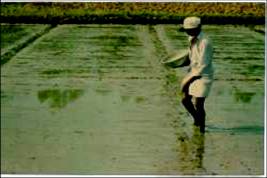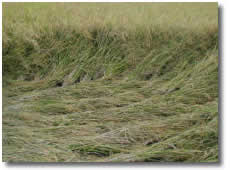|

|
|
Planting
|

|
|
|
|
|
|
|

|
|
Planting techniques: Direct seeding
|
|
|
|
|
|
|
|

|
|
Describe direct seeding
|
|
|
|
|
|
|
|
|
|
Introduction
One method of planting rice is by direct seeding. In this lesson, we will focus first on direct seeding rice with dry land preparation, then on direct seeding on wet land.
|
|
|
|
|
How is direct seeding on dry land done?
In rainfed anddeepwater ecosystems, farmers often sow onto a dry soil surface and then incorporated the seed either by ploughing or by harrowing. Avoid incorporating the seed too deeply into clay soils or where surface sealing is a problem. In some deepwater rice areas, the seed is not incorporated after broadcasting. Germination occurs following rain or floods.
To get good plant establishment, the farmer should check the seed quality, , amount of seed, and expected availability of water.
The target number of plants to be established ranges from 100 to 150 plants per square meter. Some plant rearrangement (transplanting) might be needed after establishment to even up plant stands.
Dry direct seeding can be done by:
1. broadcasting
2. drilling
3. dibbling
|
|
Broadcast = sowing seed by scattering it
|
|
Dry land direct seeding techniques
|
|
1. Broadcasting
You can broadcast 80 to 100 kilograms of seeds per hectare evenly on the field or in furrows in a 1 hectare field.
Make shallow furrows by passing a along the prepared field. After broadcasting, cover the seeds using a .
|

Broadcasting without and with furrows
|
|
2. Drilling
Another technique is drilling 80 to 100 kilograms of seed per hectare by hand on prepared furrows, or by mechanical seed drillers.
A benefit of drill seeding is that fertilizer can be applied at the same time as the seed. Also manual weeding is easier in machine-drilled crops than in broadcast crops.
In Asia, mechanical planting of dry seed is seldom practised, but in Australia and the United States, seed is often placed by a seed drill into both dry and moist soil and then irrigated. A smooth, level seedbed is necessary to ensure that seeds are not planted at depths greater than 10 to 15 mm.
|

Drilling by hand or by driller
|
|
3. Dibbling (hill planting)
The third technique is dibbling, or hill planting. This is usually practiced along mountain slopes or where plowing and harrowing are difficult. Use a long wood or bamboo pole with a metal scoop attached at the end for digging holes. Then drop the seeds into the holes and cover them with soil.
|

Dibbling on mountain slopes
|
|
|
|
|
How is direct seeding on wet land done?
The method of wet direct seeding is often used in irrigated areas and can be done by:
1. broadcasting, or
2. drilling seeds into the mud with a drum seeder.
For both methods, you need to use pre-germinated seeds. Click to learn how to pre-germinate seeds.
|
|
|
|
Wet land direct seeding techniques
|
|
1. Broadcasting
Seeds can be broadcast onto recently drained, well-puddled seedbeds or into shallow standing water in the fields. If water in the fields is muddy following the last working, the field is allowed to dry for a time period of at least 24 hours (preferably 48 hours) before broadcasting commences.
If water is drained from the fields after broadcasting, it is re-introduced 10 to 15 days after seeding.
You need to broadcast 80 to 100 kilograms of pre-germinated seeds per hectare.
|

Broadcasting pre-germinated seed
|
|
2. Drilling with a drum seeder
The manually operated drum seeder is a fast planting technique that can be used for wet seeding. It operates best on a seedbed that is very level, smooth and wet.
A problem of the drum seeder is that uneven seeding may occur: many seeds are dropped when the operator stops, and then no seeds are dropped until the seeder has moved forward for a small distance. This uneven seeding leads to an uneven plant stand and follow-up transplanting may be required. The newest kinds of drum seeders perform better.
You need to drill 80 to 100 kilograms of pre-germinated seeds per hectare.
|

A drum seeder reduces labor requirements

The seed holes of the drum seeder
|
|
|
|
What are the advantages and disadvantages of direct seeding?
|
|
|
|
There are 2 advantages to using direct seeding:
|
|

|
1. It requires less labor. You do not have to prepare a nursery, care for it, and pull the seedlings.
|
|

|
2. Direct-seeded plants mature 7 to 10 days earlier than transplanted rice. They are not subjected to stress like being pulled from the soil of the nursery and do not need to reproduce fine rootlets.
|
|
However, it also has disadvantages:
|
|

|
1. In direct seeding, the seeds are exposed to birds, rats, and snails.

Seeds are exposed
|
|

|
2. There is greater crop-weed competition because rice plants and weeds are of similar age.
|
|

|
3. Plants tend to lodge more because there is less root anchorage.

Lodging of the plants
|
|

|
4. More seeds are required:80 to 100 kilograms per hectare compared with 35 to 65 kilograms per hectare with transplanting.
|
|
|
|
|
|
|
Go online for more information
|
|
For more information on Crop Establishment, please visit: http://www.knowledgebank.irri.org/PlantEstablish/WebHelp/default.htm
|
|
Next lesson
|
|
In the next lesson we will discuss transplanting in more detail.
|

|









